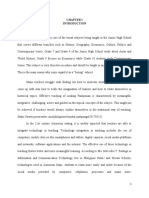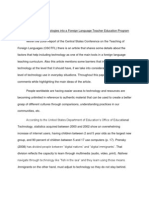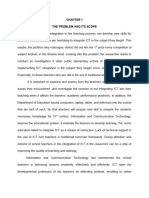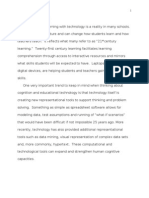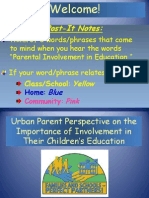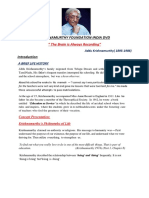Prof Ed 17 (Module 3)
Prof Ed 17 (Module 3)
Uploaded by
Jemilyn PalangdaoCopyright:
Available Formats
Prof Ed 17 (Module 3)
Prof Ed 17 (Module 3)
Uploaded by
Jemilyn PalangdaoOriginal Title
Copyright
Available Formats
Share this document
Did you find this document useful?
Is this content inappropriate?
Copyright:
Available Formats
Prof Ed 17 (Module 3)
Prof Ed 17 (Module 3)
Uploaded by
Jemilyn PalangdaoCopyright:
Available Formats
St.
Louis College of Bulanao
Purok 6, Bulanao, Tabuk City, Kalinga 3800
ROLES OF EDUCATIONAL TECHNOLOGY
This chapter will enable you to discern the roles of educational technology which will
help in selecting particular lessons and situations where technology can be applied. This
knowledge will help you in designing activities and projects with the appropriate
technology application.
Intended Learning Outcome
At the end of the chapter, students are expected to:
infer the roles of educational technology in the 21st century classroom based on
research findings.
ENGAGE
Beliefs about Educational Technology
The history of educational technology reveals that many educators, parents, and
Students believe the reason for using technology learning are based be in two major
beliefs; (1) technology is composed of tools to facilitate learning, thus should be used
in education and (2) research has shown the effectiveness of computer-based
methods. Both of these commonly held belief have some validity and both provide
reasons for using technology. The fast development in technology require us to
answer the following questions:
• Since technology can assist the students in many ways, how should it fit with
what teachers already do?
• At which level of students, topics, or activities should schools rely on computer-
based methods?
• Does some reliable information suggest specific benefits for using technology in
education?
The teachers must identify specific contributions that technology can and should
make to an improved students' achievement through teaching and learning with the use
of the computer gadgets. The teachers must create their vision, define technology's role
in the schools, then plan for its use. The rationale identified for using technology will be
the guide in setting the goals, the skills and resources needed to accomplish these goals.
The Four Pillars of Education and the 21st Century Skill
Each learner must consider education as a life-long learning and certain skills are
associated with each pillar of education. There are four pillars of education, namely:
Learning to learn, Learning to do, Learning to live together, and Learning to be.
Educational Technology is closely related to the four pillars because techn010U skills
and tools help the learner attain them.
Learning to learn enables one to address coping with situations that need
knowledge, greater intellectual curiosity, shapes the mental faculties and enables one to
make judgement on the things and situations they experienced. Technology assists them
Grand Master Zilong
to carry on with learning more efficiently through surfing in the computer, discovering
through research and applying gadgets to facilitate the acquisition of knowledge.
Learning to do equips one with certain skills to undertake certain tasks to be
productive and competent. The learner puts into action what they learned and the task
is translated to actual manipulation or productivity. Learning to do does not stop at this
point but, a learner should do the task over and over again to attain skills leading to an
efficient performance. Technology is applied along with the task of doing something.
Learning to live together provides the individual the potential for harmonious
relationship with people around them. It also emphasizes the idea about unity in
diversity in terms of race, religion, and personal beliefs. Social media helps people to be
connected and understand other people's reactions by focusing on others point of view.
Forum for dialogue and discussions could help lessen the gap among peoples'
differences, in the world of work, in the community and in the world collaborative
projects, social activities, humanitarian actions, and membership in organizations are
some ways to enhance the learners' ability to learn to live together.
The last pillar, learning to be, gives an individual a picture of what he plans to be
after certain periods in his lifetime. The learners outlook about himself may vary
from time to time as he realizes certain episodes in his life. Example is, at a young
age, he wants to finish his elementary schooling, then secondary schooling and later
the tertiary preparation for the world of work. This pillar will provide a goal to an
individual on the specific knowledge, competencies, and tasks which one should
acquire for a successful life. This may concern aesthetic, artistic, scientific, cultural,
social and developing imagination and creativity. The learner can also discover
technologies which will be necessary in attaining what he wants to be.
ELEMENTS FOR USING TECHNOLOGY IN EDUCATION
The following elements are justifications for the use of technology:
Element 1. Motivation
Gaining Learner Attention
According to learning theorist, Robert Gagne, gaining the learner's attention is
a critical first event in providing optimal conditions for instruction. Although
other aspects of instruction must direct this attention toward meaningful
learning, the visual and interactive features of many technology resources seem
to help focus students' attention and encourage them to spend more time on
learning task (Pask-McCartney, 1989; Summers, 1990-1991). Substantial
empirical evidence indicates that teachers frequently capitalize on the novelty
and television-like attraction of computers and multimedia to achieve the
essential instructional goal of capturing and holding students' attention.
Students enjoy watching situations where they seemed to be the key players.
Thus, some teachers utilize characters whom the students like to be associated
with in preparing their lesson materials. Modules that portray typical behavior of
students in their age group can catch their attention much better.
Encouraging the Learner through Production Work
Production work makes learning more meaningful to students. The teachers
often try to engage them in creating their own technology-based products. This
strategy has been used effectively with word processing (Tibbs, 1989; Franklin,
1991), hypermedia (Volker, 1992; LaRoue 1990), computer-generated art
(Buchholz, 1991), and telecommunications (Taylor, 1989; Marcus, 1995). Students
seem to like the activities because they promote creativity, self-expression, and
Grand Master Zilong
feelings of self-efficacy and result in professional-looking products they can view
with pride.
Other production work among students using technology are creating some art
projects for the children in the community as part of their community immersion
activities Another example is creating a product which can be sold for an
entrepreneurial project The product can be derived from surfing in the computer
and looking for resources in the community.
Increasing Perceptions of Learner Control
Many students are motivated by feeling, they are in control of their own
learning (Amone & Grabowski, 1991; Relan, 1992). Learner control seems to have
special implications for at-risk students and others who have experienced
academic failure. When students perceive themselves as in control of their
learning, the result has been called intrinsic motivation, or being motivated by the
awareness that they are learning. This finding reported from the earliest users of
computer-based materials, is considered as one of the most potentially powerful
reasons for using technology resources as motivational aids. However, when
learning paths become complex (with hypertext environments and interactive
videodisc applications), students with weak learning skills seem to profit most
when teachers supply structure to the activities (Kozma, 1991,1994; McNeil &
Nelson 1991).
Some teachers use concept diagram to make the students understand better the
interrelationships of various concepts. An example is the study of the solar system.
The teacher can show the concept of distance from the sun through diagram of the
distances of the different planets from the sun; the concept of movement around
the sun; and the concept of having additional bodies revolving around the planets
like the moon for earth.
Technology Use as Motivation
Motivating students to learn more has assumed greater importance in recent
years as we recognize strong correlations between dropping out of school and
undesirable outcomes such as criminal activity. The drive to keep students in
school is an urgent national priority. Technology has an important role to play in
achieving this goal. Kozma and Croniger (1992) described several ways in which
technology might help to address the cognitive, motivational, and social needs of
at-risk students; Bialo and Slivin (1989) listed several software packages that were
either designed or adapted to appeal to these kinds of students. Technology-based
methods have successfully promoted several kinds of motivational strategies that
may be used individually or in combination.
Another reason for technology use is the motivation among students to enroll in
schools where teachers teach using technology. Research findings showed that this
was the reason given by college freshmen for enrolling in certain institution of
higher learning.
Element 2. Unique Instructional Capabilities
Element 2 which deals with instructional capabilities is closely related to the
four pillars of education, namely: learning to know, learning to do, learning to be
and learning to live together.
They set the use of technology in molding the individual to meet the demands of
the 21st century through the following.
Linking learners to information sources (Learning to know)
Grand Master Zilong
Helping learners visualize problems and solution (Learning to do)
Tracking learners' progress ( Learning to be)
Linking learners to learning tools.
Another powerful reason for using technology
resources, is that some technological media can
facilitate unique learning environments to be more
powerful and effective. A module can be used as an
example for this. The students can work
independently using the computer or a hard copy during times when motivated to
study. Some modules on the computer are animated. Furthermore, students are
exposed to varied technology materials which enable them to learn independently.
The students enjoy working on it while learning to know. Animated exercises with
different movements to show whether their responses to the questions are correct
or not appeared to be unique on the part of the learner.
Linking Learners to Information Sources
Through hypertext systems, as seen on many Internet Web pages, students
can select a keyboard from a screen and get pointers from several other sources
with information on the same topic. These lead to other related sources and
topics, forming an endless chain of information. Kozma (1991, 1994) reports
that, while little research has focused on hypertext to date, preliminary findings
suggest that hypertext learning environment "both calls on and develops skills
in addition to those used with prescribed books and reference materials".
Computers handle the logistics of this complex activity.
Enabling Learners Visualize Problems and Solutions
Kozma (1991) also reports that interactive visual media (videodisc
applications) seem to have unique instructional capabilities for topics that
involve social situations or problem solving. He notes that these media provide
powerful visual means of "representing social situation and tasks such as
interpersonal problem solving, foreign language learning, or moral decision
making". The growing number of videodisc and CD-ROM products designed for
these kinds of topics (the AIDS videodisc from ABC
News, Computer Curriculum Corporation's Success Maker) confirms that
designer and educators are recognizing and exploiting these unique and
powerful qualities.
Tracking Learners' Progress
Students' progress can be recorded and reported in many ways. Preparing
a portfolio on class accomplishment can be recorded in a log book or in an
electronic diary A system of recording students' progress can be done through
computers, program which can be availed of by both the students and the
parents within and after a grading period.
Linking Learners to Learning Tools
Grand Master Zilong
There are many ways by which the learners can use technology to link with
information needed in their lessons and in solving problems for lifelong
learning Several computer programs enable students to solve statistical data,
researchers about different topics and other data related to their interests
ranging from humanities, the arts, communication history and many more.
Element 3. Support for New Instructional Approaches
The educational system is struggling to revamp its instructional goals and
methods in preparation for the complex demands of life in the technology-driven
21st century (SCANS Report, 1992). Educators are beginning to look at technology
resources to help make these new directions at once feasible and motivational to
students. Several new instructional initiatives can benefit from applications of
technology:
Cooperative Learning. Cooperative learning demonstrates the value of small groups
with members coming from different learning abilities. Many technology-based
activities lend themselves to cooperative, small-group work: development
hypermedia products and special-purpose database and research projects using
online and offline databases and videodiscs and multimedia. Example is development
of a project done by a small group. Each member has a task to do to complete the
task Making an activity card for a project in chemistry can be an interesting work
like testing acid and metal. Each member can contribute an observation to
differentiate one from the other. A rapporteur can be assigned to list down all the
observation: to be reported to the class.
Small groups can utilize their computers using and studying the teacher's
power point presentation of the lesson. In this case, they have a grasp of what
are expected from them to discuss during class time. In this case, the teacher
gives a copy her powerpoint to the class leaders of small groups for an
advanced reading discussion. The time for small group discussion can be done
outside class time. Class participation can be enhanced and discussion can be
livelier. In cooperative learning students also experience learning to live
together.
Shared Intelligence. An emerging definition for intelligence is termed shared
intelligence or distributed intelligence. According to some theorists, the
capabilities afforded by new technologies make the concept of intelligence
as something that resides in each person's head too restrictive.
Intellectual partnership with computers suggests the possibility
that resources enable and shape activity and do not reside in one or
another agent but are genuinely distributed between persons, situation and
tools" (Polin, 1992).
Many students at present feel confident in doing research work due to the
speed of surfing in the internet. During recitation, they refer to their iPod
or small computers to immediately get the ideas being asked from them.
• Problem Solving and Higher-level Skills
Students can solve problems and represent their knowledge by engaging in
higher level skills. Problem solving can be done by:
• Sensing the problem
• Researching the problem Formulating the problem
• Finding the alternatives
Grand Master Zilong
• Choosing the solution
• Building acceptance
All of the above processes involve higher-level skills (Jonnaser, Daird 1999).
Element 4. Increased Teacher Productivity
• Freeing time to work with students by helping with production and record
keeping tasks
• Providing more accurate information quickly
• Allowing teachers to produce better-looking, more "student-friendly"
materials quickly
Using technology resources can help teachers cope with their growing
paperwork load. Teachers and organizations realized that they spend less
time on record keeping and preparation so they can spend more tune
analyzing student needs and having direct contact with students. Teacher
can be more productive through training in technology-based methods and
access accurate information that may help
them meet individual needs. Any technology resource can help teachers increase their
productivity; word processing, spreadsheet, database, grade book, graphics, desktop
publishing, instructional management and test generator programs along with online
communications between teachers (e-mail) and other online services. The teachers can
be encouraged to prepare interesting teaching materials for their students efficiently in
a shorter time. A compilation of this materials can lessen their workload when they
teach the same subject in the future.
Element 5. Required Skills for an Information Age
The final and most compelling reason for integrating technology into teaching and
learning is the need for students to learn skills that will prepare them to become lifelong
learners in an information society. They need to be equipped with the skills to learn to
know by gathering information in addressing problems in school and in real-life
situations. Since the emergence of the Internet, many processes involved in locating and
communicating information now involve some form of technology.
Technology Literacy
Soloman (1995) says that "Technology for students is about economic
competitiveness". The International Society for Technology in Education (ISTE), the
group that collaborated with the National Council for the Accreditation of Teacher
Education (NCATE) to develop educational technology standards for pre-service
programs, also developed the National Educational Technology (NET) for K-12
students. Standards for all students are shown in Table 4.1; standards specific for
each grade level are also available. Both sets of standards are recognizing that
technology skills are becoming required job skills. Several states (e.g. North Carolina)
are also establishing their own required technology skills for K-12 students. This trend
makes it essential that teachers both model and teach the use of technology-based
methods to their students.
Grand Master Zilong
Develop positive attitudes toward technology use that support lifelong
learning, collaboration, personal pursuit, and productivity.
3. Technology productivity tools
Students:
Use technology tools to enhance learning, increase productivity, and
promote creativity.
• Use productivity tools to collaborate in constructing technology-
enhanced models, preparing publications and producing other creative
works.
4. Technology communication tools
Students:
• Use telecommunications to collaborate, publish, and interact with peers,
experts and other audiences.
• Use a variety of media and formats to communicate information and
ideas effectively to multiple audiences.
5. Technology research tools
Students:
• Use technology to locate, evaluate and collect information from a variety
of sources.
• Use technology tools to process data and report results.
• Evaluate and select new information resources and technological
innovation based on the appropriateness to specific tasks.
6. Technology problem-solving and decision-making tools
Students:
• Use technology resources for solving problems and making informed
decisions.
• Employ technology in the development of strategies for solving problems
in the real world.
Information Literacy
Although information literacy skills may be simply a subset of the techn0100'
literacy skills, some educators think they are so important that they should receive
Grand Master Zilong
special emphasis (Truett, 1996; Roblyer, 1998). Johnson and Eisenberg (1996)
introduced the "Big Six" skills namely, 1) task definition, 2) information-seeking
strategies, 3) location and access, 4) use of information, 5) synthesis, and 6)
evaluation. The information explosion fostered by the Internet has made the Big
Six skills more important to learning and more involved with technology. However,
Roblyer (1998) notes that students seem to find the first three skills-the ones
requiring use of technology procedures-more enjoyable and easier to do. It is the
application and analysis tasks that present the most difficulty. However, all these
skills appear likely to be essential ones. These skills are also emphasized in the
21st century skills under information, media, and technology skills.
Visual Literacy
Visual literacy is considered as subset of technology literacy. Christopherson
(1997) & Roblyer (1998), emphasized the need for improved visual literacy skills so
many people are heavily using images on visual communications. Christopherson
(1997) affirmed that a visually literate person can interpret, understand, and
appreciate the meaning of visual messages; communicate more effectively through
applying the basic principles and concepts of visual design; produce visual messages
using the computer and other technology; and use visual thinking to conceptualize
solutions to problems. Roblyer (1998) reports on research that correlates visual
literacy skills to higher scores on intelligence tests and to later success in more
technical vocational areas such as engineering. Christopherson observes that
"students with visual communication skills are more marketable" but these skills
will soon be required rather than merely desirable. These reports create a powerful
reason for teachers to integrate technology at early levels into students'
communication methods.
The research findings reveal the importance of visual literacy among teachers.
They must utilize well-planned images when preparing instructional materials to
capture the real essence of what they like to convey to the learners. Here, technology
will make this task easier. Illustrations and pictures are found in the computer
which they can easily access and use.
Grand Master Zilong
You might also like
- CH01 Managing: A Competency Based Approach, Hellriegel & JacksonDocument30 pagesCH01 Managing: A Competency Based Approach, Hellriegel & Jacksonsweetyraj89% (9)
- Reading Klein by Margaret Rustin, Michael RustinDocument204 pagesReading Klein by Margaret Rustin, Michael RustinMariana Oseguera100% (1)
- HPGD1103 Curriculum DevelopmentDocument15 pagesHPGD1103 Curriculum DevelopmentUina Jo100% (1)
- Instructional Technology and Theory by Robert WhelanDocument5 pagesInstructional Technology and Theory by Robert WhelanKangdon Lee100% (1)
- Department of Education: Republic of The PhilippinesDocument2 pagesDepartment of Education: Republic of The PhilippinesDiana Grace Andaya100% (4)
- Approaches of Values EducationDocument1 pageApproaches of Values EducationKyla Mariz Arellano50% (2)
- Developing Bridging Leadership Capital WorksheetDocument1 pageDeveloping Bridging Leadership Capital WorksheetAlodia FarichaiNo ratings yet
- The Last Self Help Book You'll Ever Need Repress Your Anger, Think Negatively, Be A Good B PDFDocument295 pagesThe Last Self Help Book You'll Ever Need Repress Your Anger, Think Negatively, Be A Good B PDFRahul Taneja67% (3)
- Chapter 4 BookDocument11 pagesChapter 4 BookRose Mae S. TecsonNo ratings yet
- Prelim Week 4 Lesson Roles of Educational TechnologyDocument6 pagesPrelim Week 4 Lesson Roles of Educational TechnologyCecelien Salgado AntonioNo ratings yet
- Roles of Educational TechnologyDocument43 pagesRoles of Educational TechnologyBhyu Jin HyunNo ratings yet
- Unit 4 - Roles of Educational TechnologyDocument8 pagesUnit 4 - Roles of Educational TechnologyAVEGAIL SALUDONo ratings yet
- Unit 4 - Roles of Educational TechnologyDocument8 pagesUnit 4 - Roles of Educational TechnologyAVEGAIL SALUDONo ratings yet
- Technology For Teaching and Learning 1 ReportDocument34 pagesTechnology For Teaching and Learning 1 ReportMichaella RamosNo ratings yet
- Background of The StudyDocument20 pagesBackground of The StudyAzariah Amaziah HananiahNo ratings yet
- 1.0 Intro-Wps Office-1Document10 pages1.0 Intro-Wps Office-1Patrick SuleNo ratings yet
- Research ProjectDocument6 pagesResearch ProjectPablo SernaNo ratings yet
- MODULE FOR TEACHING AND LEARNING TECHNOLOGY 2 Revised 2022 NewDocument47 pagesMODULE FOR TEACHING AND LEARNING TECHNOLOGY 2 Revised 2022 NewZedZed Forca100% (1)
- ResearchDocument6 pagesResearchaleahjayneborromeoNo ratings yet
- Final Research 1 5 3Document87 pagesFinal Research 1 5 3Charles Bognot0% (1)
- Technology: Positive and Negative Effects On EducationDocument9 pagesTechnology: Positive and Negative Effects On EducationJhena MarieNo ratings yet
- Assignment, Technology in Education Advantages and DisadvantagesDocument11 pagesAssignment, Technology in Education Advantages and DisadvantagesIJAAZ ASFARNo ratings yet
- Instructional Technologies and LearningDocument21 pagesInstructional Technologies and Learninggarlene mae colinares100% (1)
- M1T1-2 Group3 BEEd201 EdTech1Document5 pagesM1T1-2 Group3 BEEd201 EdTech1Regina Vera Lisondra OracionNo ratings yet
- Reymark Cobita - Research PaperDocument59 pagesReymark Cobita - Research PaperReyna Jane YuntingNo ratings yet
- Educational Technology 2 SummaryDocument10 pagesEducational Technology 2 SummaryrinaNo ratings yet
- Effects of Using Technology As An Educational Tool For Senior High School Students in Mystical Rose School of Bulacan INC. S.Y. 2018 - 2019Document29 pagesEffects of Using Technology As An Educational Tool For Senior High School Students in Mystical Rose School of Bulacan INC. S.Y. 2018 - 2019Christine Joyce S. CruzNo ratings yet
- Practical Research 1 Group 4Document11 pagesPractical Research 1 Group 4Arlyn OchinangNo ratings yet
- Meaning of Educational TechnologyDocument10 pagesMeaning of Educational TechnologyReading HubNo ratings yet
- 2Document21 pages2Isa Res Tocalla ResNo ratings yet
- Research 10Document12 pagesResearch 10Abdur DapitillaNo ratings yet
- Complete ResearchDocument36 pagesComplete ResearchcarieNo ratings yet
- SPETTL Lesson 2Document7 pagesSPETTL Lesson 2Mito VNo ratings yet
- Edtech 2 SummaryDocument17 pagesEdtech 2 SummaryAnalyn MarimonNo ratings yet
- Thesis Chapter 1 3Document33 pagesThesis Chapter 1 3NORFIDHA diabo100% (1)
- Bagong New Research Compiled Chap 1 5 ReferencesDocument67 pagesBagong New Research Compiled Chap 1 5 ReferencesFiona DelaCruzNo ratings yet
- Ped109 080812Document5 pagesPed109 080812fcity1773No ratings yet
- Lesson 1-2 (EDUC 204)Document9 pagesLesson 1-2 (EDUC 204)Ella DavidNo ratings yet
- BACO FOR PRINTING2. FINALxxDocument40 pagesBACO FOR PRINTING2. FINALxx1G- MAPA, KARLA MAYSONNo ratings yet
- Integrating Technology Was Founded in 2006 byDocument11 pagesIntegrating Technology Was Founded in 2006 byCyrus Joaquin ArcaynaNo ratings yet
- Integrating Technology Was Founded in 2006 byDocument11 pagesIntegrating Technology Was Founded in 2006 byCyrus Joaquin ArcaynaNo ratings yet
- Tongcua Thesis OutlineDocument12 pagesTongcua Thesis OutlineAnonymous 2CFbLhRZZkNo ratings yet
- Educ 630 - Personal Philosophy PaperDocument6 pagesEduc 630 - Personal Philosophy Paperapi-512731660No ratings yet
- GUBAT Sheila Educational Strategies For Technology EducationDocument15 pagesGUBAT Sheila Educational Strategies For Technology EducationEdgar DenagaNo ratings yet
- The Roles of Information Communication Technologies in Education Review Article With Emphasis To The Computer and InternetDocument16 pagesThe Roles of Information Communication Technologies in Education Review Article With Emphasis To The Computer and InternetWaseemNo ratings yet
- Intor Technologies To Teachers Neena Thota - Christines ArticleDocument15 pagesIntor Technologies To Teachers Neena Thota - Christines Articleapi-248773056No ratings yet
- Reflection Paper Educ 103Document3 pagesReflection Paper Educ 103Joey Anne BeloyNo ratings yet
- Reflection Paper Educ 103Document3 pagesReflection Paper Educ 103Joey Anne BeloyNo ratings yet
- Curriculum Paradigm of Technology Education in The PhilippinesDocument13 pagesCurriculum Paradigm of Technology Education in The Philippinesruth eliezer alcazarNo ratings yet
- Research ProposalDocument36 pagesResearch ProposalJessa Mae JabegueroNo ratings yet
- Educ 204 Midterm ReviewerDocument15 pagesEduc 204 Midterm ReviewerRea Marie Joy CalimlimNo ratings yet
- TTL Lesson 3Document5 pagesTTL Lesson 3Katlyn MRNo ratings yet
- Thematic RRL of Teachers' Level of Expertise On Modern Day TechnologyDocument11 pagesThematic RRL of Teachers' Level of Expertise On Modern Day TechnologyLourainne Faith AloceljaNo ratings yet
- Module 14 Bringing The World Into The Classroom Through Educational TechnologyDocument6 pagesModule 14 Bringing The World Into The Classroom Through Educational TechnologyshielaNo ratings yet
- Module-14-Bringing-The-World-Into-The-Classroom-Through-Educational-Technology (-1Document7 pagesModule-14-Bringing-The-World-Into-The-Classroom-Through-Educational-Technology (-1shielaNo ratings yet
- Teaching and Learning With Technology Is A Reality in Many SchoolsDocument20 pagesTeaching and Learning With Technology Is A Reality in Many Schoolshymen11No ratings yet
- 02 DanielaDocument25 pages02 DanielaMIHAINo ratings yet
- Module 4-Lesson 4.3Document4 pagesModule 4-Lesson 4.3Kel LumawanNo ratings yet
- Current Trends and Issues in Distance Education Educ 631 Research PaperDocument20 pagesCurrent Trends and Issues in Distance Education Educ 631 Research Paperapi-368062041No ratings yet
- Final Project - Srebrina AyladanovaDocument7 pagesFinal Project - Srebrina Ayladanovaapi-321972208No ratings yet
- Group 5 - The Effects of Technology in Students' Academic PerformanceDocument11 pagesGroup 5 - The Effects of Technology in Students' Academic PerformancePhilip Llave100% (2)
- Review of Related StudiesDocument12 pagesReview of Related StudiesKhrissyl Ann Delagao SolidoNo ratings yet
- Final Research 12 CrystalDocument23 pagesFinal Research 12 CrystalLyra Jean SorianoNo ratings yet
- Design and Technology: Thinking While Doing and Doing While Thinking!From EverandDesign and Technology: Thinking While Doing and Doing While Thinking!No ratings yet
- Emerging Technologies for the Classroom: A Learning Sciences PerspectiveFrom EverandEmerging Technologies for the Classroom: A Learning Sciences PerspectiveNo ratings yet
- Using Cutting-Edge Technology: Tools to Consider for Enhancing Learning In Grades Six through TwelveFrom EverandUsing Cutting-Edge Technology: Tools to Consider for Enhancing Learning In Grades Six through TwelveNo ratings yet
- ProjectDocument44 pagesProjectapi-257035857No ratings yet
- Research Methodology: An Introduction: K.BalajiDocument17 pagesResearch Methodology: An Introduction: K.BalajiUttam Kumar SahooNo ratings yet
- GM Heritage Adolescent CommunityDocument1 pageGM Heritage Adolescent Communityapi-240122431No ratings yet
- SWP 335 - Final Exam ReviewDocument12 pagesSWP 335 - Final Exam Reviewdcadenas1No ratings yet
- Ferrer, E. M. (2013, Abril) - Gamificación y E-Learning: Un Ejemplo Con El Juego Del Pasapalabra. en Recuparado deDocument1 pageFerrer, E. M. (2013, Abril) - Gamificación y E-Learning: Un Ejemplo Con El Juego Del Pasapalabra. en Recuparado deElnaz NasirzadeNo ratings yet
- Ogl 220 Module 4 Assessment WRKSTDocument3 pagesOgl 220 Module 4 Assessment WRKSTapi-576628086No ratings yet
- Relationship Between Work Readiness PDFDocument5 pagesRelationship Between Work Readiness PDFAlyssa Mae LunodNo ratings yet
- CH 7Document16 pagesCH 7omahachemNo ratings yet
- The Art of The RPGDocument1 pageThe Art of The RPGapi-582911813No ratings yet
- Unit 10 CommunicationDocument3 pagesUnit 10 CommunicationlauraNo ratings yet
- Emotional UnderstandingDocument8 pagesEmotional UnderstandingJackylyn PambidNo ratings yet
- Name of The Student: Twinkle Kashyap Enrollment No: 04815901714 BBA, Semester V (Morning Shift) Batch: 2014-2017 Subject Code: BBA 303 Subject: Sales ManagementDocument11 pagesName of The Student: Twinkle Kashyap Enrollment No: 04815901714 BBA, Semester V (Morning Shift) Batch: 2014-2017 Subject Code: BBA 303 Subject: Sales ManagementTwinkle KashyapNo ratings yet
- Reflection Intervieuw QuestionsDocument7 pagesReflection Intervieuw Questionsapi-431335551No ratings yet
- G11 DLL DescriptiveDocument2 pagesG11 DLL DescriptiveAnnie Ang100% (2)
- Culture and Entrepreneurial1Document25 pagesCulture and Entrepreneurial1Anonymous 1RJKm7No ratings yet
- Kajee Aadila 2019Document146 pagesKajee Aadila 2019MaisieNo ratings yet
- Tukang Suun Anak-Anak: Bentuk Eksploitasi Orangtua Terhadap Anak (Studi Kasus Di Pasar Badung, Denpasar-Bali)Document15 pagesTukang Suun Anak-Anak: Bentuk Eksploitasi Orangtua Terhadap Anak (Studi Kasus Di Pasar Badung, Denpasar-Bali)Eric PrimaNo ratings yet
- Drugs, Addiction, and The Brain. 1st Edition.Document23 pagesDrugs, Addiction, and The Brain. 1st Edition.ronasalvidortbk100% (10)
- A Tale of Three Encounters in One Day: Damian MiltonDocument6 pagesA Tale of Three Encounters in One Day: Damian MiltonyeyesNo ratings yet
- Understanding Business Ethics LessonDocument9 pagesUnderstanding Business Ethics LessonDrgemeNo ratings yet
- Clinical Case HistoryDocument3 pagesClinical Case HistoryNazra NoorNo ratings yet
- KRISHNAMURTHY FOUNDATION INDIA DVD Minakshi MaamDocument8 pagesKRISHNAMURTHY FOUNDATION INDIA DVD Minakshi MaamArnavNo ratings yet
- Top 12 Brain-Based Reasons Why Music As Therapy Works: Karen MerzenichDocument5 pagesTop 12 Brain-Based Reasons Why Music As Therapy Works: Karen MerzenichpitamberrohtanNo ratings yet
- English7 q3 m3Document4 pagesEnglish7 q3 m3Eljean LaclacNo ratings yet














